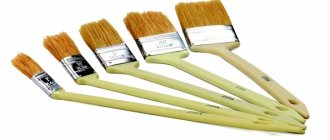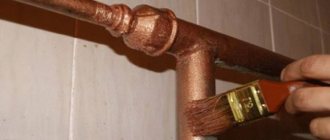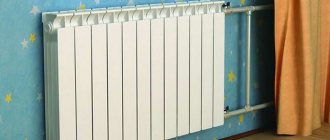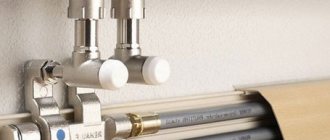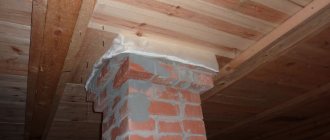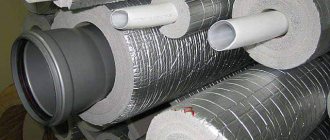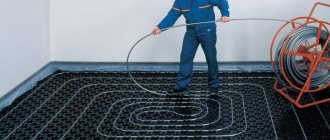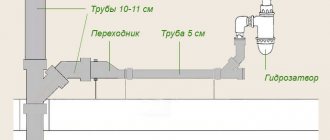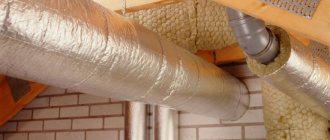Andrey Grigoriev
We built a wooden fence, metal pillars, tell me whether it is necessary to close the top of the pipe near the pillars and what is the best way to do this? Plastic plugs specially designed for this purpose. https://www.zaglushka.ru/ Water will fill up in autumn and break pipes in winter. You can weld the caps You can stick the bottles in Make it easier, at the bottom of each pillar, drill holes for the water to drain from the pipe. On the good, the pillars should be painted, although if the metal on the pipes is normal, then it will stand for twenty years without painting, it will not go anywhere, here is the question ...
Artem Spekhin
I want to paint one piece of iron. Sand and degrease, prime and paint. the best to chrome the piece of iron goes through several baths with acid.You can cover it with yellow, white and black chrome the most reliable will be.
Victor Lebedev
What happens if you paint a slightly rusty metal tube with enamel? Will the paint adhere? Or peel off? Well, clean off the rust, what's in the scrap? the more "slightly rusty" First, there are special paints for rusted metals. But all the same, you must first degrease the pipe with vodka (or an alcohol-containing liquid), and then paint. If you roll in a thin layer, then hold out for 1 year! If with ordinary paint, it will peel off. There are rusty paints.
Yuri Antsyferov
That year, the craftsmen painted the heating pipes with good paint, and during this heating season it turned yellow. Even the best paint fade and turns yellow from the temperature. It is better to do hidden installation of pipes in the wall. I covered the pipes with a primer gf-021 (gray) and I doubt whether I need to paint the color of the walls. And so good. Be glad that it did not fall off but turned yellow, perhaps because the pipes are rusty and will soon be replaced
Alexey Sukin
What exactly do you hate in the interior of the apartment, which is considered by many to be "classics of the genre"? You can list and enumerate Sideboards, patterned carpets, antediluvian curtains, stools, dressers, dressing tables, and so on. In general, I love minimalism and cleanliness in the interior. And minimalism in the interior is just not minimalism in ... Curtains, wallpaper in a flower with sequins, laminate, linoleum imitating parquet, white plastic windows, bar counters in the kitchen
Vitaly Negushin
Every day, morning and evening, I kiss my "Mercy" on the nose. Gray do you wear lipstick? Not a boutique, but a paint store, look in the city's shops Buy Nickel-plated paint, remove the badge, wipe the badge with sandpaper, prime and paint It is necessary to go kissing in the backside it will not be so noticeable Seryonya, do not frighten, otherwise the boys will run away right now You are Sergey, MAN! It is necessary to rip off a mercik every evening in the exhaust! Haaaaaaa!
Timofey Barmin
How to paint the grilles on the windows if they are already covered with rust? First, paint with a rust converter — it is sold in household stores (this is orthophosphoric acid) —it binds the rust. Then primer and crust with ordinary paint. or Alifa passed on top with paint Buy a rust converter. process, and then cover with automotive enamel (for metal Remove rust with sandpaper, rinse with kerosene, paint with a primer, paint with enamel
Vladimir Sumarokov
How to paint the pipes in the bathroom and in the toilet so that they do not rust and then the paint does not hang on the burdocks? First you need to remove the old one, then prepare the pipes (if rusty or dirty), degrease with some kind of solvent, wipe off dust at least Enamel paint is needed (color is apparently white), alkyd, it happens for heating pipes ... Clean as much of old paint and rust as possible and Hameright. Only made in England.
Lyubov Bedanova
How to improve the appearance of an old country refrigerator Paint with gouache We pasted over with self-adhesive film.
If you are going to paint all the same, and not apply photographic printing, then I will add: there is a primer for car paint! And the putty must first be cleaned off the rust (there will already be an unevenness under it) or dry it slightly with an anti-rust remover ... If it is cheaper then buy acrylic paints and paint like your heart desires or yourself (from the bulldozer PARDON! or by stencil
Konstantin Donkov
What paint to paint a large metal container? To protect against corrosion! My brother painted the metal barrel with B-EP-433 enamel. The paint has been holding for quite a long time! I know that I ordered enamel on this site https://9715151.ru/Katalog/emali/emal-b-ep-433 Outside, the simplest thing is to enamel on rust. And if we are talking about the inner surface, then, for example, VL-023 soil (1 layer), then VL-515 enamel, at least 2 layers.
Yulia Krotova
How to make an extremely economical bathroom renovation? Can the walls and floor not be tiled? And what then? Tile on the floor, 1 meter below with plastic panels (horizontally) on top - with decorative plaster (or paint) the joint between the panels and the wall, close the tile corner. Paint the ceiling and glue the foam border. It looks very nice ... You can make an exopan, cheaper and not a little worse
Anna Morkovkina
How and what to paint rusty pipes in the bathroom? Now there is paint on rust. In the store, ask and they will tell you everything. Change them to new metal-plastic ones. You don’t know how thick their walls are. They may burst. First, they must be cleaned of rust and old paint. It is better to paint with oil paint. It is moisture resistant.
Vadim Okunev
What must you do when you move into a new apartment? Instructions for a newcomer? Somewhere in the depths of human consciousness, the belief has firmly settled that cats are somehow connected with evil spirits, and "a raven will not peck out a crow's eyes," and, therefore, the cat itself is not in danger. In addition, the owners relied on the wise ... Soak the apartment so that in the morning there was something to remember. First of all, before letting a cat or cat into a new apartment, you should inspect your future home. You need to start examining a new apartment from surfaces: floors, walls and ceilings. Of course, you shouldn't expect them to be perfect ...
Alexander Gubanin
Is there a heat-resistant paint for rust? Uh-huh bitumen There is a heat-resistant one, but I never met it for rust. Have you decided to paint Glushak? I look at the pipes myself and take longing. Hammerayt burnt, heat-resistant rusts I painted a wood-fired titanium pipe, well, very rusty, with heat-resistant paint and adhered very well (gradual heating is recommended after painting) And it's not destiny to clean the rust?
Yaroslav Apraksin
Plumbing. You know, I advise you from personal experience, it's easier to hire a plumber, to do everything humanly, from modern materials and forget for LONG years, than to make "snot" again With a little blood to get rid of the stench, cement the hole around the hose .... 1-pull out the hose and clean the cast-iron pipe from everything, go to the store (market) of sanitary goods and buy a transitional rubber coupling from 70 to 40mm (as I understand it for your HOSE) -all 2 - water goes through the mixer into the pipe (cold) that you need a pipe ...
Anastasia Mudyugina
Corrosion of stainless steel. What is the name of this type of corrosion? Oxidation The first time I see such crap on stainless steel, I still understand rusty streaks, but such a Low-quality metal. Summary: clean the metal, heat it up, cover it hot with a primer. There is corrosion or it is not present! Don't care if it's stainless steel or not. Corrosion of metal is an oxidation process, stainless steel resists more than ferrous metal, but the essence does not change from this Your fence looks like galvanized, or anodized ....
Natalia Kukina
What color scheme is your bathroom? Do you buy towels to match?
Pipe painting: tips from professionals to self-taught
and the plumbing is white or also in tone? We have a shared bathroom. The tiles are blue on the floor, the walls are up to half blue, the walls are white higher, the ceiling is slatted with built-in lamps, the shower curtain is also blue with fish. Plumbing is white, towels of all colors of the rainbow For many, nothing has changed since the construction in the USSR. gamut one - walls painted with half blue paint, and the rest whitewashed, rusty risers
Victor Lyzhin
How to paint a rusty pipe? how to process, in what sequence and with what paint. Thank you. Buy a rust and paint converter according to the instructions. and then upstairs with any paint or there is a special paint for painting rusty surfaces! There are no problems with this right now there is paint 3in 1 for rust In a blunt emery teranul, Peel off the husk, and forward Well, I don't know, we can have a better way
Gennady Sukhoi
Can radiators be painted with car paint? Who painted, share your experience: how does it behave when heated? Heating radiators can even be painted with water-based paint, and even more so with automobile paint. Yes, I heard. that they paint and the result is good. I did not paint, and the paint is not intended for high temperatures: 80 degrees, maybe it can withstand. You know, it may crack at high temperatures. By the way, if you have old paint on pipes, then maybe the paint will swell….
Zhanna Iglina
How to paint a rusty pipe? How to process it in what sequence and what is the best paint? Metal brush (or drill attachment), rust converter, degreaser, primer, paint. To paint on metal, best of all with paint for AUTO from a bologna, if the area is not large, I painted the heating pipes for it, they are as good as new for 5 years. Remove the layered grout with a metal brush, degrease and paint either "Hameright" or "Spetsnaz"
Reasons for the formation of condensate Prerequisites for the appearance of condensation on cold water pipes How to remove condensate, how to wrap the pipes Chemical elements that help to get rid of condensation Device for draining condensate - condensate drain
Condensation can almost always be observed on cold water pipes. This phenomenon not only spoils the appearance of the bathroom to some extent, but can cause serious problems. Constantly wet tubing has a limited life.
Therefore, such a problem should be solved very quickly. In this case, questions arise, what to do if water drops are found on the pipeline and how to remove condensate from cold water pipes. First, you don't need to over-dramatize the situation. Secondly, you need to familiarize yourself with all methods of eliminating this problem. Thirdly, choose the most optimal option and apply it in practice.
How to work with a chrome heated towel rail?
If a modern heated towel rail does not fit into the bathroom interior, its appearance can also be changed. Not every paintwork material is suitable for chrome: most either slide off or are quickly erased from the surface of the product. You will have to do sanding or sandblasting, removing the chrome plating to bare metal. After that, you can prime and paint the coil in the usual way.
If there is no desire to carry out such serious preparation, you can buy high-quality paint brands Tessarol, Hammerite and apply it directly to the chrome, however, the price of the work will be quite high. Before painting, you do not need to sand, priming - you can simply degrease the product with any solvent.
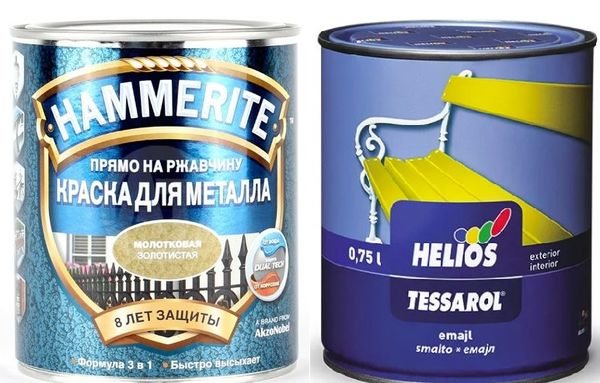
Painting a heated towel rail is not too difficult and tedious task, it can be done independently. A new product will last a long time when choosing a high-quality paint, so there is no need to save on material.
Reasons for the formation of condensation
Condensation on cold water pipes may appear for the following reasons:
- The presence of a source of high humidity in the room.
- Insufficient ventilation.
- Water supply pipes are of poor quality insulation.
- Temperature changes. For this reason, in the summer, there may be a stronger formation of condensation, which simply flows down the surface of the pipes.
Most of the reasons for the formation of condensation are self-explanatory. As for the first item from the list, some clarifications are required.
Sources of high humidity include the following:
- Problems arising in the process of functioning of communication systems and buildings. This can include steam generation during cooking, evaporation from wet laundry, a flooded basement, a pipeline accident, and debris clogged ventilation.
- Building defects resulting from a violation of construction technology.
- The geographical features of the region: the close location of large bodies of water or high humidity levels in combination with rocky soil, which contributes to the formation of condensation.
- Unfavorable natural phenomena: wet snow, prolonged rains or humid local climate.
Water droplets can appear on pipes, both for each of the reasons separately, and with the combined effect of all of the listed conditions.
If in the first case, the problem is not of great importance, then the second situation requires an immediate search for a solution to the problem, how to protect pipes from condensation (read: "How to eliminate condensate on cold water pipes - causes of occurrence, ways to solve the problem").
Prerequisites for the appearance of condensation on cold water pipes
In most cases, condensation appears on the pipes located in the bathrooms. Despite the specificity of these premises, it is not only for this reason that the pipes become wet.
There are a number of factors that can cause condensation to form on toilet pipes:
- Insufficient ventilation. To determine that condensation appears precisely because of this, it is enough to leave the toilet doors open at night. If the pipeline turns out to be dry in the morning, then you should repair the ventilation system and make it better.
- Constant flow of water in the tank due to valve malfunction. This leads to the fact that the pipeline begins to cool down, as a result of which a greater accumulation of condensate is noted on its surface. A simple repair of the inlet valve and tank taps will help fix the problem.
- Leaking in the toilet of the neighbors living on the top floor. In this case, you need to inform the owners about the situation that has arisen. In their absence, you can temporarily eliminate the condensation with your own hands. For this, the section of the pipeline, on which the accumulation of water droplets is found, is wrapped with a bandage in several layers and one end of the winding is lowered into the container, the accumulated water is regularly poured out.
Preparatory work
The efficiency of all work will depend on the quality of preparation: if you do not give the product perfect smoothness, the paint will not be able to adhere to its surface.
Cleaning the base
The old coating must be removed completely so that no paint or varnish remains. This can be done with sandpaper, a metal brush, but if you have a grinder, a grinder, then the work will go much faster. Professionals often use sandblasting machines to remove paint from metal. A chemical remover or a hot air gun is also suitable for this purpose.
Before carrying out preparatory work, put on gloves, glasses, and a respirator. Organize good ventilation of the room or clean the heated towel rail in the open air.
They act in this way:
- Brush off the most poorly fixed pieces of paint, removing them in layers.
- Work with sandpaper cracks, corners, bends.
- Corrosion elements, if any, are especially carefully removed.
- They wash the heated towel rail with water and detergent, removing all the smallest particles of paint, dirt and evaluating the result.
- Once again, the metal is cleaned if untreated zones are revealed.
- Dry the base, then wipe it with a degreaser.
- If there was rust on the metal, apply an anti-corrosion compound to all surfaces.
We suggest that you familiarize yourself with Mold in the bathroom on the ceiling: how to remove, remove, how to process, how to fight on your own
Priming is the final stage in preparing a heated towel rail for painting. The choice of soil must be carefully, because it must also be resistant to high temperatures and be well suited for metal surfaces. It is best to buy an alkyd primer and apply it in a thin, even coat. After drying, you must repeat the process again.
Dyeing
Difficulties with painting usually do not arise, all work is done with a brush:
- Mix the paint thoroughly until smooth.
- Gently dip the tip of a narrow brush into the paint, apply it to the upper parts of the heated towel rail - this will help to avoid drops, drips.
- The product is completely colored, the material is allowed to dry (usually 2-3 hours).
- Repeat painting 1–2 more times.
- After 4–5 days, the coil is put into operation.
Instead of a brush, you can use a small spray bottle. It will allow you to apply the product without streaks, in a strictly uniform layer, while there is no risk of hairs appearing on the surface of the product.
Spray paint should be thinner than a brush, so a little thinner should be added.
The main thing when painting a metal heated towel rail and pipes is a high-quality cleaning of the surface not only from old paint, but also from rust. The anti-corrosion treatment cannot be ignored: a new focus of rust will quickly begin to form under the paint, and the paintwork will begin to snap off.
Galvanized pipes usually do not require painting as they have a strong protective layer on the surface. But if it is necessary to stylize the heated towel rail, it can also be treated with an alkyd or silicone compound of the desired color. Before applying it, the base must be primed: without this, the quality of adhesion will greatly decrease. Before painting, check that there is no condensation on the object.
Polymer products are also painted only for the purpose of making changes to the interior of the room, while the work does not require anti-corrosion measures, but priming is mandatory. For plastic, paints are used without acetone and other aggressive solvents in the composition.
How to remove condensate, how can you wrap pipes
Those who are faced with such a phenomenon immediately have the question of how to wind the pipe so that there is no condensation. There are several ways to prevent the appearance of water droplets on the surface of cold water pipes, one of which is thermal insulation. This option is considered the most effective, since it eliminates the cause of their appearance - the temperature drop. The easiest and fastest way to solve the problem is by means of an insulating tube, cutting it lengthwise for convenient placement. Foamed polyethylene, energoflex or thermoflex are used for the manufacture of the tube.
There is another way to deal with condensation on pipe elements, but it is considered more complicated. Using this option requires the following materials: epoxy putty, acetone, rust remover, sanding paper, spatula, nylon thread and strips of fabric about 5 cm wide.
Chemicals that help get rid of condensation
Chemical industry products such as Stermizol, Korund, Teplomett and others help protect cold water supply pipes from condensation.
The use of these insulating mixtures implies the following actions:
- The pipe is cleaned of dirt and rust.
- Apply a layer of primer for better adhesion of the insulation to the surface and leave to dry.
- Using a roller, brush or spray gun, cover the surface with a protective mixture. The most effective is the application of 5 layers of insulation, and each layer must dry well before the next application. The optimum drying time for such mixtures is about 1 hour.
- A special fixer helps to extend the service life of the heat-insulated pipeline, which, in parallel, will make the pipes more attractive.
Which way to use to combat condensation on cold water pipes depends on the reasons for the formation of this phenomenon and the specific operating conditions. It is very important to consider how often the problem occurs, as well as at what stage it is.
What will it take to work?
List of tools:
- a spatula, wire brush and sandpaper for removing waste paint and abrading;
- gloves;
- protective glasses;
- plastic wrap and masking tape to insulate adjacent walls and floors;
- paint brush or roller;
- stock of clean rags for wiping surfaces.
Materials will require paint, a rust converter and a degreasing liquid (in the case of metal pipes), a primer (if the painting technology requires it). For painting work, it is better to wear unnecessary clothing with long sleeves and cover your hair with a headdress.
Condensate drain - condensate drain
A float steam trap is used to automatically drain the formed condensate. This device is installed at the outlet of an apparatus that provides heat exchange, including water heaters and air heaters. By means of such a technical device, the water accumulated in the system is simply evaporated.
Steam traps are divided into three main groups:
- Combined type devices.
- thermostatic.
- Float.
Float type steam traps operate by exploiting the density difference between condensate and steam. These devices are very popular due to the large number of positive characteristics.
The main advantages of this type of device are the following:
- High degree of reliability.
- Excellent performance indicators.
- Ability to work at minimum loads.
- No need for condensate cooling.
- Resistant to sudden temperature changes.
- Uninterrupted operation at increased loads.
Also, one cannot fail to note the optimal indicators of energy saving of thermal systems with float-type steam traps.
To combat condensation, you can choose any of the listed methods. In most cases, using them helps to eliminate unwanted moisture. If these options are not effective enough, it is possible to get rid of the formation of condensation on the pipes of cold water supply by waterproofing all surfaces of the room. High-quality performance of this type of work is possible only with special knowledge and skills.
Choice of paint
The selection of a high-quality composition is very important, because it is this material that will determine the aesthetics of the result, the service life of the coating. Ordinary paints and varnishes will not work: the heated towel rail heats up regularly and they will crack instantly. When buying, you need to pay attention to heat resistance: the paint for the heated towel rail must withstand heating up to + 120 ... + 180 degrees.
Also, a high-quality material for painting the coil should have the following properties:
- resistance to the action of water, the possibility of using in damp rooms,
- resistance to wear, friction, mechanical stress,
- anti-corrosion properties, no components harmful to metal in the composition.
As for the color, you should choose a tone suitable for a particular bathroom, corresponding to the theme, style direction. Most often, users choose paint for chrome, silver, gold, and other metallic coatings. Heated towel rails in black, dark blue, red look original.
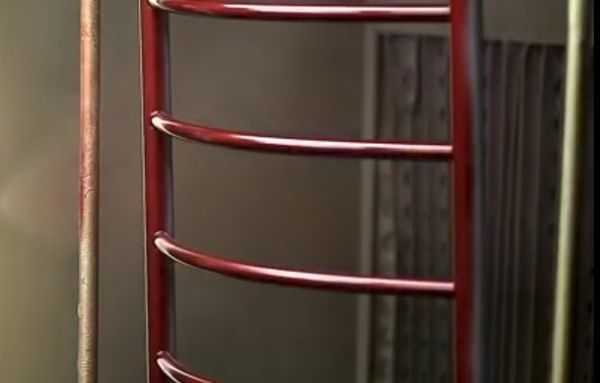

If desired, shades can be combined, and paints can be mixed with each other. It is not recommended to buy only white paintwork materials - even the most resistant material from temperature extremes will lose color and become yellowish.
Oil paints
Such products are not suitable for working with heating surfaces. They quickly lag behind the base, have insufficient adhesion, are not heat-resistant, besides, they have an unpleasant smell and have a short service life.
Acrylic paints
Compositions based on acrylic do not emit harmful fumes, do not smell, thanks to the smooth texture, they are applied easily and ideally even in a layer, do not leave streaks, streaks. Acrylic paints dry in a short time, have a high degree of adhesion to surfaces. They also have disadvantages: poor chemical and mechanical resistance, rapid abrasion.
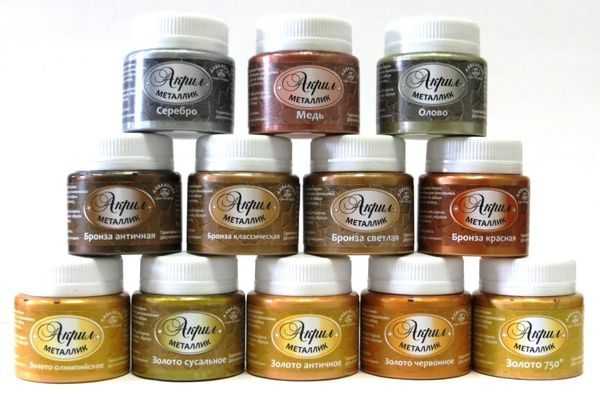

Silicone paints
Such paints are based on rubber and other resins diluted with water or organic solvents. The material in the form of a suspension is durable, does not deteriorate from the action of high temperatures, lasts a long time (up to 15 years), wear-resistant, moisture-resistant. Paints with solvents are especially reliable, but until dry they give off a pungent odor.
Alkyd enamels
Paints based on glyphtal or pentaphthalic varnish and special pigments are considered heat-resistant (withstand up to +180 degrees), therefore they are ideal for heating pipes, batteries, radiators and heated towel rails. The finished coating does not snap off for a long time, does not darken or crack.
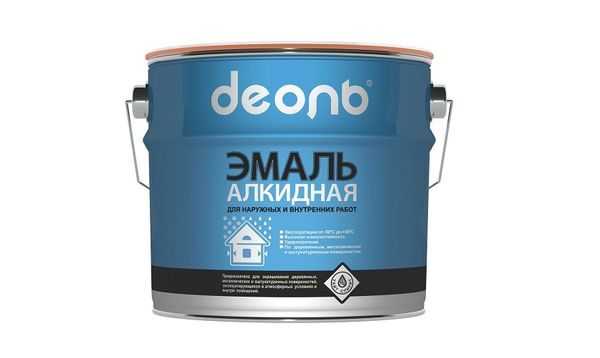

The service life of the paintwork is at least 10 years, while the film is resistant to the action of water, household chemicals, and mechanical factors. It is better to choose matte or silky-gloss alkyd enamels of the desired color: they look the most beautiful. These paints have only one drawback: they contain solvents, so they emit an unpleasant odor for several days.
bathroom pipe paint
Modern dwellings, among other things, consist of various engineering structures and communications, including: a gas pipeline, sewerage, water and heat supply, telephone and Internet networks. Some of their components, such as pipes, may need protection against corrosion. To do this, it is best to paint them. Apart from a practical purpose, the paint will give the pipes a pleasant appearance. The only condition for this operation is the ability to get to the pipes.
Perhaps, for residents of many houses and apartments, this problem is not relevant. Currently, water pipes are designed from metal-plastic and polypropylene. Nevertheless, there are still a lot of iron pipes in operation, primarily located in summer cottages. It was from them that water pipes were installed for irrigation of crops in the plots. Water supply pipes must be re-painted every spring. How to do this is described below.
How to prepare surfaces for painting?
The selection of a high-quality composition is very important, because it is this material that will determine the aesthetics of the result, the service life of the coating. Ordinary paints and varnishes will not work: the heated towel rail heats up regularly and they will crack instantly. When buying, you need to pay attention to heat resistance: the paint for the heated towel rail must withstand heating up to 120 ... 180 degrees.
Also, a high-quality material for painting the coil should have the following properties:
- resistance to the action of water, the possibility of using in damp rooms,
- resistance to wear, friction, mechanical stress,
- anti-corrosion properties, no components harmful to metal in the composition.
As for the color, you should choose a tone suitable for a particular bathroom, corresponding to the theme, style direction. Most often, users choose paint for chrome, silver, gold, and other metallic coatings. Heated towel rails in black, dark blue, red look original.
If desired, shades can be combined, and paints can be mixed with each other. It is not recommended to buy only white paintwork materials - even the most resistant material from temperature extremes will lose color and become yellowish.
We suggest that you familiarize yourself with the Karcher device for washing windows: device, instructions for use, advantages and disadvantages
Oil paints
Such products are not suitable for working with heating surfaces. They quickly lag behind the base, have insufficient adhesion, are not heat-resistant, besides, they have an unpleasant smell and have a short service life.
Acrylic paints
Compositions based on acrylic do not emit harmful fumes, do not smell, thanks to the smooth texture, they are applied easily and in a perfectly even layer, do not leave streaks, streaks. Acrylic paints dry in a short time, have a high degree of adhesion to surfaces. They also have disadvantages: poor chemical and mechanical resistance, rapid abrasion.
Silicone paints
Such paints are based on rubber and other resins diluted with water or organic solvents. The material in the form of a suspension is durable, does not deteriorate from the action of high temperatures, lasts a long time (up to 15 years), wear-resistant, moisture-resistant. Paints with solvents are especially reliable, but until dry they give off a pungent odor.
Alkyd enamels
Paints based on glyphtal or pentaphthalic varnish and special pigments are considered heat-resistant (withstand up to 180 degrees), therefore they are ideal for heating pipes, batteries, radiators and heated towel rails. The finished coating does not snap off for a long time, does not darken or crack.
The service life of the paintwork is at least 10 years, while the film is resistant to the action of water, household chemicals, and mechanical factors. It is better to choose matte or silky-gloss alkyd enamels of the desired color: they look the most beautiful. These paints have only one drawback: they contain solvents, so they emit an unpleasant odor for several days.
The general rule for pipes made of ferrous metal: clean the steel from rust, first coat with a primer, only then paint.
To paint metal pipes you will need:
- Tools for cleaning the pipe surface from rust and old paint: grinder, grinder, impeller, sandpaper, spatula.
- Household chemicals to prevent rust and remove its remnants.
- Brush "flutes" or roller.
- Primer for metal pipes
- Rags
- Covering material to prevent paint from spilling onto surrounding objects.
- Gloves.
Do not paint rusty pipes, they need to be prepared. Corrosion traces are completely removed with a hard wire brush and sandpaper. Phosphoric acid-based rust removers can only help by modifying small, hard-to-reach areas of corrosion left over from machining.
Old pipes and batteries are cleaned of rust, and if they want to get a neat look, they also remove old paint.
To paint a metal pipe, you should choose primers and paints based on organic solvents. Water-soluble ones cannot be used. Of the primers, the domestic GF-021 has an excellent price / quality ratio.
Instructions for the primer GF -21.
We can recommend domestic oil paints, pentaphthalic paints, ours and imported alkyd paints. If a primer is available, an aqueous topcoat can also be used.Today, manufacturers also offer universal coloring compositions that simultaneously function as a primer and paint. It is more convenient to work with them, because you can paint a steel water pipe or cast iron pipe in one go.
You can paint pipes and radiators in any color that matches the interior design
As for heated towel rails, modern models are made of stainless steel or have an electroplated coating, you only need to paint very old ones, made of ordinary metal.
For pipes and radiators, it is convenient to use such an L-shaped brush with a long handle, with its help you can paint hard-to-reach places
Galvanized water pipes do not need to be painted, except in places where the threads are manually cut, where the coating is broken. It is impossible to weld galvanized steel, but if this has already been done, the seam should also be protected.
There is no need to paint plastic pipes, they are not afraid of external influences, except that ultraviolet radiation. The application of the coating can be justified by aesthetic considerations, because typical colors (white, gray, less often beige and green) do not always and not everyone satisfy in open areas. Manufacturers offer, as for metal, special primers for plastics.
Materials for painting plastic pipes. The best choice is any aqueous composition, including for mineral surfaces: dispersed, emulsion, acrylic, organosilicon. Conventional water-soluble wall paints will wear off with constant hygienic cleaning, but there are those designed for joinery, they are resistant, wash well, have good adhesion. Sufficiently neutral acrylic and pentaphthalic, based on white spirit, are suitable.
Plastic pipes do not need painting, 90% are standard white or gray
We suggest that you familiarize yourself with How to clean bathroom tiles and seams
It is not difficult to paint the water pipes in the bathroom or the heating in the room; you can do it yourself. Or, if repairs are being carried out in an apartment or house, entrust it to specialists, it will be better if the plumbers immediately protect the metal with a primer.
Water-based acrylics. In everyday life, they are often called water-based paints. Materials of this group are distinguished by their safety for the environment, withstand temperature drops and heating up to 90 ° C, and are easy to work with. Acrylic paints dry in half an hour and, after drying, do not stain your hands and things hung on the dryer. However, their strength is lower than that of other materials, so the coil will have to be repainted periodically. Example: enamel for radiators "Rainbow".
Alkyd paints are also suitable for heating pipes. They are stronger than acrylics, so they are suitable for long-term use. Alkyd paints and varnishes contain anti-corrosion additives that provide reliable protection of metal from rust in contact with water and steam.
The disadvantage of this type of paint is a pungent smell during painting and at first after it. In this regard, it is necessary to carry out painting work in a protective mask and with a wide open door. Then the bathroom should be thoroughly ventilated during the day. Examples: enamel for radiators "Novax", "PF-115", paint-primer on chrome "Empire", car alkyd enamels.
Silicate paints. They withstand heat and temperature fluctuations well, do not require preliminary application of a primer composition. When working with them, a strong unpleasant odor is emitted, therefore, care should be taken to protect the respiratory tract and ventilation. The service life of such paints is about 10 years. Example: Hammerite black metal dye.
Polyurethane paints and varnishes for metal. They can be colorless or colored in a variety of shades, including gold, bronze and brass. They fit well even on polished or chrome-plated steel, do not need a preliminary primer.Thixotropic varnishes, due to special additives, are able to change their consistency (liquefy with stirring and thicken at rest).
Alternative finishing methods include powder painting. However, this version of work cannot be carried out independently at home, since it requires a workshop equipped with a polarizing camera. The heated towel rail is dismantled, placed in a chamber and dry pigment is sprayed on it.
The resulting paint layer is very durable and highly durable, so it will be difficult to repaint such a coil if desired in a different color. To do this, you will have to remove not only the paint, but also the surface layer of the metal.
Preparation for painting iron pipes
Before you start painting water pipes, you need to determine what they are made of. Also, their temperature is important for the choice of paint. In addition to paint and a brush, it will be impossible to do without sanding paper, gloves, rags, cuvettes and primer. If the pipes are covered with old paint, it must be removed. After their surface is cleaned of it, it will need to be sanded. This removes rust. After that, the surface of the pipes is degreased. Then all the garbage is removed, and fresh air is allowed into the room. Only after all this does the staining begin. To prevent paint from dripping onto the floor, hold the brush over a container.
How to prepare surfaces for painting?
Stages of preparing a metal structure for painting:
- check the serviceability of the pipe, make sure that there is no leakage on its body and at the points of connection to the water supply lines (if a leak is found, it is eliminated before the start of painting work);
- turn off the hot water supply or wait until the end of the heating season (since the increased temperature can interfere with the polymerization process);
- remove the old paintwork layer with sandpaper or with the help of a special paint thinner (corrosion centers can be hidden under it, in addition, old and new paints may belong to different, incompatible groups);
- carefully inspect the surface, apply a special solvent to rusty pipes and remove rust (if there are severely pitted areas on the heated towel rail, then it should be dismantled and replaced with a new one in order to avoid a rupture in the near future);
- degrease and dry (this can be done with a universal solvent, acetone, gasoline or white spirit).
As for structures made of polymeric materials, they are sanded before painting to remove the surface glossy layer that interferes with good adhesion of the paint. Do not try to degrease polystyrene or PVC pipes, as most organic solvents used for this will damage and deform the plastic.
If it is possible to dismantle the coil, then it is better to use it. In this case, it will be much more convenient to paint and you will not have to wash the walls from paint splashes.
Where to start coloring?
A pipe that is easily accessible is much easier to paint than one that is difficult to approach. This applies to risers and radiators. It should be painted, starting from the top and moving downward. It is important not to leave unpainted areas on the surface. The second layer should be painted when the previous layer is dry.
Plastic pipes are prepared differently for painting. After washing with warm water, they are allowed to dry. Oil or water-based paints are best suited for them. What color of the wall, the same should be the pipe.
How to paint black pipes?
The most susceptible to corrosion are communication pipes made of ferrous metals - steel and cast iron. In order to protect them from possible destruction and extend their service life, they should be painted. And before that, carry out thorough preparation: wipe off the dust and clean out the rust.
It is important that the paint is applied to a dry surface. Cast iron and steel pipes are best painted with enamel, which includes a rust converter, a primer with anti-corrosion functions and the enamel itself, which has high wear protection. It is necessary to paint over the pipe surface well using two layers.
How to paint a sewer pipe?
Recently, plastics have been used in the manufacture of sewer networks. And this material does not need the protective functions of paint. So you can paint only a metal line to give the protruding pipe a decent look.
As you know, paints exist for all surfaces, and even for plastics. To purchase the desired paint and varnish product, you need to find out what the pipe is made of (this should be written on it), and what paint is recommended for it, according to the specialist. Play it safe by reading the paint can label.
If the pipe is metal, but still not so simple. Rather, it will be easy to paint it, but it is problematic to prepare it for painting. This is due to the fact that some of the sewer networks are within sight, and some are reliably hidden. In this case, a construction hairdryer can help.
Beginning of work
Modern materials from which heated towel rails (coils) are made have high strength, are reliable, do not lose their external gloss during the entire service life. But the old plumbing, especially the one that is already covered with several layers of paint, has long lost its beauty and former functionality. It is precisely this that has to be restored by pre-cleaning the rough coating to metal. If the preparation is done poorly, the new layer of paint will quickly fall behind.
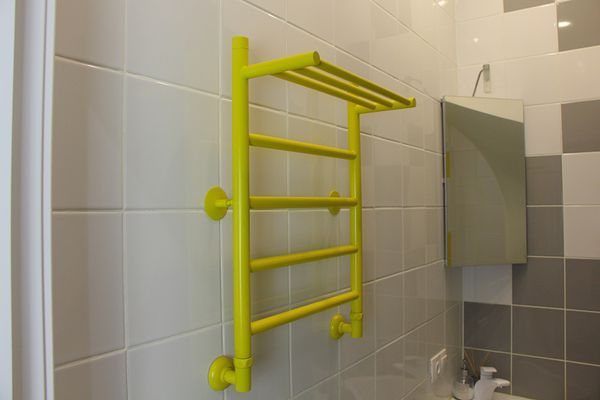

It is important to know where to get started with your heated towel rail. The first step is to prepare a set of screwdrivers to remove the device from the wall. First, you need to turn off the water, let the coil cool completely, because it is under heating. When paint is applied directly to hot metal, it will dry instantly and the finished coating will be unstable. In addition, the evaporation of solvents from the paint will begin to proceed more intensively, which means that the harm to health will increase.
It is best to schedule work on painting the heated towel rail during the seasonal hot water shutdown. This will help prevent flooding of neighbors even in a situation where the coil does not have a separate shut-off valve. Thus, all actions for painting the device are carried out after dismantling the heated towel rail and cooling it down to room temperature.
Paint the pipe in the bathroom
With its help, the cleaned surfaces that are in the public domain will be dried. The paint should be chosen so that it can withstand high temperature and humidity (important for bathrooms).
How to calculate the color of pipes?
It is quite difficult to immediately figure out how much paint you need to buy for pipes. After all, its consumption is calculated in square meters on a flat surface. The following knowledge can help in calculating the amount of paint:
- A lot of paint is wasted when you have to paint in hard-to-reach places. Because small strokes obviously consume more paint. The first coat takes up more paint than the next. A smooth surface absorbs paint less than an uneven one.
- You also need to remember that a hot pipe dries faster than a cold one. The same thing happens when painting it with spray paint.
Back to the list
What paint to choose for the coil?
In Soviet times, the question of how to paint the dryer in the bathroom was solved simply: they took any enamel paint that matched the color. And no matter that the result was far from ideal, there was still no particular choice. Fortunately, in the modern construction market, you can pick up high-quality and durable paints and varnishes. It is worth focusing on brands that:
- suitable for application to metal surfaces;
- resistant to high temperatures and sudden changes in thermal conditions;
- have anti-corrosion properties.
Silk-alkyd enamels and acrylic paints intended for heating radiators have such characteristics. From foreign brands, it is worth paying attention to Tikkurilla products. In its assortment, among other things, there are compounds intended for application to rust. Of the domestic ones, the compositions of TM Lakra have proven themselves well. You can also find a suitable paint option in car stores. By the way, they sell aerosol formulations, which will be much more convenient to apply.
Important! Don't buy boiling white coil paint. Even the highest-quality composition will acquire a yellowish tint over time under the influence of temperature. Therefore, it is better to immediately choose milky shades.
Bathroom plumbing paints
Because we pay them for it!
Learn more
leonidos
Rank: 54
02 March 2020 at 16: 28 I'm getting ready for the next repair and the question arose: how to paint the pipes of the water conduit for a longer period, so that it would have a nice look. I always painted the riser and the wiring with PF115 enamel, but over the course of a year, the look of my pipes became not entirely attractive, the paint faded and in places generally darkened. Maybe there are more resistant and new coatings for such purposes, those who know and have tried, are ready to accept advice. Patrik1111
Rating: 5
March 02, 2020 at 17:25 From the temperature difference on the riser, condensation collects all the time - and this is dampness, from which any paint will suffer. Of course, you can try something expensive, but it's not a fact that it will last long. Andrey
Rank: 59
02 March 2020 at 07:23 PM I always painted cast-iron pipes with ship's red lead. It is inexpensive, resistant to humid environments and looks better than a rusty pipe painted with a different paint. Although there is also bitumen varnish ("Kuzbasslak"). It is no less effective, but it has a radical black color. Although you can add silver or bronze to it, then the color will be more pleasant. evgeny
Rating: 6
02 March 2020 at 08:21 pm Paint with water-based paints, which are specially designed for heating pipes. They dry quickly, stay on the pipes for a long time, when working with them, a specific smell is not felt (as with others). komarov
Rating: 16
03 March 2020 at 7:07 am Before painting the water pipes, take some time to remove the paint (and rust) they have been painted with. Still, it would not be bad to degrease them. If you paint without these "procedures", after a year you will do everything all over again. leonidos
Rank: 54
03 March 2020 at 22: 51The proposal to use a ship's red lead for painting water conduit pipes interested me, but once I met this type of paint and it had a typical orange color. I would like the paint to have a blue tone somewhere, perhaps? NekitVP
Rating: 25
March 05, 2020 at 04:14 PM I have always painted pipes with paint for heating radiators, it is always good to go to bed and is resistant to temperature changes and temperature expansion, it can be easily collected in any color by almost any caller, I have never regretted it. Root
Rank: 127
05 March 2020 at 16: 26Paint with the same PF-115, and so as not to darken on top, cover with a layer of alkyd varnish from an aerosol can. The varnish is more stable than paints and enamels (there are no fillers in them) and under it the paint will remain in its original form many times longer than without a protective varnish layer. Leonid_32
Rank: 230
05 March 2020 at 18: 56In addition to all this, it is also important to add a stage of coating pipes with a primer. Moreover, the pipes should not be covered with condensate until completely dry. One of the best options is an alkyd-based primer. It perfectly protects metal surfaces.
How to paint a sewer pipe. Sequence of work
Over time, sewer pipes deplete, wear out, lose not only aesthetic appearance, but also functionality.In this case, you have to either completely change the sewer system, or renew the old pipelines. Of course, repair work will be cheaper, and in some cases this solution can extend the life of the sewer by more than one decade.
One of the simplest and most effective ways to repair the sewer pipeline, to refresh its appearance is the usual painting. But often the owners do not know how to paint the sewer pipe correctly, what tools will be needed for this, what compounds to use.
Particularly relevant is painting in an apartment where cast-iron pipes are far from the first freshness. Metal tends to corrode. It literally eats up the material, causing leaks, breakouts. The paint solves two problems at once - it renews the aesthetic qualities of the pipeline, and fights against corrosion.
Compositions for painting cast iron pipes
The choice of means for painting cast iron sewer pipes should be carefully thought out. Any paint will not work here. If you choose the wrong composition for painting sewer pipes, over time, the layer can peel off, fall off, collapse. Most often, the following types of paints are used for painting pipes:
Pipeline paint agent
- Alkyd paint provides high quality pipe surface painting. Its main difference is that the paint layer does not fall off when exposed to high temperatures. Individual products can withstand temperatures up to 1000 degrees.
- Water-dispersion paint refers to compositions that retain their technical properties for a long time. The main advantages of the paint are its environmental friendliness, quick drying, durability.
- After painting the sewer pipe with acrylic paint, an attractive gloss remains on it. The paint contains only natural solvents. The enamel is resistant to fading, does not crack for a long period. The disadvantage of paint is that it does not adhere well to the surface of the pipe, therefore, the pipe should be carefully primed before applying a layer of paint.
- Sometimes oil paints are also used, however, it is worth considering that they can lose their attractive appearance over time, turn yellow on pipes and gradually crumble.
Note! Before,
how to paint a sewer pipe, its surface should be carefully prepared.
How to paint plastic pipes
Plastic pipes differ in certain features compared to cast iron products. They have a very smooth surface. On the one hand, this is an advantage, since the smooth surface does not allow deposits to accumulate inside the pipe. Some types of pipes cannot be painted at all. Polyethylene and polypropylene pipes can be painted, however, paints crack and darken.
We paint plastic pipes from a bologna
So, how to paint a plastic sewer pipe? The coloring agent should be selected taking into account the following requirements:
- organic composition;
- the paint should dry in less than 12 hours (the drying time is indicated on the label);
- layer hardness and color density.
Note! Plastic sewer pipes should be painted in rooms, the temperature of which fluctuates within +18 degrees.
Before starting the painting process, the pipe surface should be carefully prepared. If this is an old cast iron pipe that has already begun to be damaged by corrosion, then you need to clean it with sandpaper.
Then the surface is degreased, a layer of primer is applied to it.
Preference should be given to priming compounds with an anti-corrosion effect, this will provide a more reliable contact between the pipe and paint, as well as prevent the progression of corrosion.
Preparation of the pipeline for painting
You also need to prepare tools and materials that you may need in the process of performing the work:
- paint for sewer pipes, selected taking into account the operational needs and technical characteristics of the pipeline;
- a bucket from which it would be convenient to get paint;
- several brushes of different sizes, preferably made from natural bristles;
- masking tape;
- primer;
- protective devices (goggles, rubber gloves).
Note! It is much easier to work with pipes that are freely available. Certain difficulties may arise when painting sewer pipes in a bathroom or toilet, where communications are hidden from prying eyes.
Sequence of work
Sewer pipes can be painted in two ways. You can paint over the old layer or completely remove it and paint over the pipe surface. The work should be performed in the following sequence:
- the choice of paint for covering the sewer pipe from a wide range presented in hardware stores;
- surface preparation, cleaning, removal of the old layer;
Painting of cast iron thick-walled pipelines - treating the pipe surface with a primer, which will protect the pipeline from corrosion;
- the pipe surface must be completely dry before applying a layer of paint, otherwise the paint will not fix and peel off soon;
- after the primer has dried, you can start applying a layer of paint.


